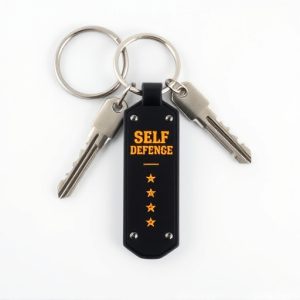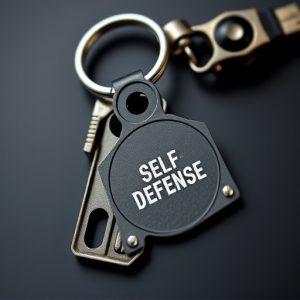Keychain Self-Defense: Market Insights and Legal Boundaries
The self-defense keychain market has seen significant growth, reflecting a heightened societal conc…….
The self-defense keychain market has seen significant growth, reflecting a heightened societal concern for personal safety. These compact security devices have become widely adopted due to their practicality and ease of use, with consumers choosing from an array of products including pepper spray, stun guns, alarms, and knives, all within legal parameters. The market caters to various demographics, including college students, elderly adults, and professionals in potentially hazardous occupations, offering devices that are both legally compliant and effective as non-lethal defense mechanisms. Innovations like GPS tracking, app connectivity for virtual safe zones, LED lights, and durable construction have enhanced their utility and appeal. The self-defense keychain business is responsive to changing consumer needs and legal requirements, ensuring its products align with societal safety trends and technological advancements. Legal compliance, particularly in marketing and product features, is critical for maintaining consumer trust and the integrity of the business within this competitive industry.
Navigating the complex intersection of personal safety, legal requirements, and consumer preferences, the self-defense keychain business has emerged as a niche yet significant market. This article delves into the essentials of launching and expanding a successful enterprise within this realm. We’ll explore current trends in personal safety devices, legal considerations for self-defense products, and the demographics that rely on these tools daily. Additionally, we’ll dissect product development, highlighting key features and material selection, while ensuring compliance with stringent safety standards. Marketing strategies tailored for the self-defense keychain business will be outlined, encompassing branding, digital tactics, and leveraging advocacy partnerships. Finally, we’ll discuss scaling strategies to transform a burgeoning business into a robust enterprise that resonates with a global audience while maintaining the highest standards of quality and innovation.
Understanding the Market Demand for Self-Defense Keychains
The self-defense keychain market has seen a significant uptick in demand as personal safety becomes an increasingly pertinent concern for individuals across various demographics. The practicality and accessibility of these compact security devices have made them a popular choice for self-defense enthusiasts and those seeking convenient protection options. The business of manufacturing and distributing self-defense keychains has, consequently, expanded to cater to this growing interest. Keychain models often incorporate functional tools such as pepper spray, stun guns, personal alarms, or slip joint knives that comply with local regulations, offering users a versatile means of deterring potential threats.
Market research indicates that the target audience for self-defense keychains spans from college students and young professionals navigating urban environments to elderly individuals seeking portable security solutions. The demographic diversity underscores the universal appeal of these products, which are not only effective as a first line of defense but also serve as everyday carry items. The self-defense keychain business must remain attuned to evolving consumer preferences and legal restrictions to maintain its relevance and effectiveness in the marketplace. Keeping abreast of technological advancements and societal shifts is crucial for businesses operating within this niche, ensuring that their offerings not only meet the immediate needs of consumers but also adhere to the highest safety standards.
– Current trends in personal safety devices
The self-defense keychain segment has seen significant innovation and growth in recent years, reflecting a broader trend in personal safety devices. Consumers are increasingly seeking compact, easy-to-carry solutions that offer both practicality and peace of mind. Keychains equipped with alarms, pepper spray, stun guns, and personal GPS trackers have become particularly popular. These devices often come with features like LED lights for visibility during nighttime encounters and durable materials to withstand harsh conditions. The integration of mobile app connectivity is another trend, allowing users to set virtual safe zones and notify emergency contacts or law enforcement directly from the device in case of an incident. The market response has been positive, with manufacturers continuously improving product designs to be more user-friendly and effective as a deterrent against potential threats. As a result, the self-defense keychain business is not just a niche market but a burgeoning industry that plays a crucial role in personal safety for individuals of all demographics. The demand for these devices underscores a collective shift towards proactive personal security measures, indicating a robust future for the self-defense keychain business.
– Legal considerations for self-defense products
The self-defense keychain market operates within a complex framework of legal considerations that businesses must navigate to responsibly offer products designed for personal safety. Legislation varying by jurisdiction dictates the permissible features and boundaries for these items. Manufacturers and vendors must stay informed on local, state, and federal laws, including restrictions on certain types of self-defense tools such as pepper spray, stun guns, or keychain alarms. It is crucial to ensure that marketing materials accurately reflect the legal status of each product and its intended use, avoiding any misrepresentation that could lead to legal complications. Additionally, businesses must adhere to guidelines related to advertising, ensuring claims about product efficacy are substantiated. By maintaining transparency and due diligence in compliance with these laws, a self-defense keychain business can establish trust with its customer base and operate within the legal confines of the industry. Understanding and implementing these legal considerations is not just a matter of adherence but also a cornerstone of building a reputable and sustainable self-defense keychain business in today’s market.
– Target demographic analysis: Who needs a self-defense keychain?
A self-defense keychain is a versatile and accessible tool for personal safety, catering to a diverse target demographic. The primary consumers of self-defense keychains are individuals who prioritize their safety while navigating urban environments or traveling in remote areas. These keychains are particularly appealing to women who often face safety concerns when alone. Additionally, college students and young professionals who frequently commute via public transportation or late-night shifts find these devices reassuring. The self-defense keychain business also targets individuals engaged in high-risk occupations, such as delivery drivers, journalists, and social workers, who may need to defend themselves in unpredictable situations. Furthermore, the aging population, particularly those who are more stationary or have mobility issues, can benefit from the convenience of a self-defense tool that doubles as a keychain, allowing them to maintain personal security without compromising on ease of use. The self defense keychain business is thus tapping into a market that values both safety and practicality, ensuring their products are not only effective but also integrated seamlessly into everyday life. These keychains offer a non-lethal, legal means of protection, making them an essential addition to the personal arsenal of safety-conscious individuals. The business must therefore focus on creating durable, easy-to-use, and aesthetically pleasing designs that appeal to the broad range of consumers looking for reliable self-defense solutions.


